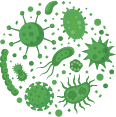Saat ini kemasan plastik banyak dijumpai di sekitar kita. Tempat makanan dan botol minum yang Anda gunakan sehari-hari banyak yang terbuat dari bahan plastik. Penggunaan plastik memang memudahkan aktivitas sehari-hari, namun plastik juga memicu penumpukan limbah mikroplastik yang berbahaya bagi kesehatan.
Apa Itu Mikroplastik?
Sebagian besar plastik yang diproduksi di dunia ini digunakan dalam kemasan makanan dan minuman. Selama pemakaiannya, plastik tersebut kemudian terurai menjadi fragmen-fragmen kecil yang disebut mikroplastik. Mikroplastik adalah partikel plastik kecil dengan diameter yang berukuran dari 1 mikron sampai 5 milimeter. Mikroplastik dapat dijumpai di mana-mana, baik produk plastik kemasan hingga produk skincare seperti scrub wajah.
Mikroplastik yang terbuat dari proses alami dapat terus terurai hingga seukuran debu. Partikel ini ada di tanah, air dan udara, hingga makanan. Artinya, ada kemungkinan kita menghirup atau memakan mikroplastik setiap harinya.
Setiap orang dapat terpapar mikroplastik dengan cara yang berbeda-beda, tergantung dari pilihan gaya hidup yang dijalani. Beberapa cara terpapar mikroplastik antara lain:
- Secara fisik
Anda bisa saja tidak sengaja menelan mikroplastik dalam makanan. Plastik berukuran sedikit lebih besar mungkin dapat keluar dari tubuh melalui feses, namun pada beberapa kasus plastik dapat terserap atau tinggal di lambung. Plastik juga dapat menjadi sarana berkembang biak bagi mikroorganisme sehingga menelan mikroplastik yang mengandung banyak mikroorganisme dapat membahayakan kesehatan.
- Secara kimia
Mikroplastik dari produk kosmetik atau produk perawatan tubuh lainnya dapat diserap ke dalam tubuh.
Baca Juga: Mikroplastik Berbahaya yang Mungkin Ada di Makanan Kita
Bahaya Mikroplastik bagi Kesehatan
Plastik yang diproduksi di dunia umumnya mengandung berbagai campuran bahan kimia yang ditambahkan oleh produsen, seperti bahan pengisi, penstabil, pelumas, plasticizer dan produk sisa seperti residu. Mikroplastik yang biasa dijumpai pada makanan dan minuman antara lain:
- Bisphenol (BPA): Bahan kimia yang digunakan dalam produksi plastik seperti galon plastik, wadah penyimpanan makan, botol minum isi ulang serta produk kebersihan.
- Dioxin: Sekelompok senyawa kimia yang merupakan hasil sampingan dari herbisida dan pemutihan kertas yang mengkontaminasi lingkungan
- Ftalat: Senyawa yang membuat plastik lebih fleksibel, transparan dan tahan lama, biasa dijumpai pada plastik kemasan
- Polietiline dan polipropilen: Senyawa yang membuat kemasan menjadi ringan dan tahan lama serta merupakan plastik paling umum ditemukan dalam makanan dan lingkungan.
Para peneliti terus melakukan penelitian mengenai bahaya mikroplastik bagi kesehatan. Beberapa bahaya mikroplastik bagi kesehatan di antaranya:
Mengganggu hormon
Terdapat senyawa dalam kemasan plastik yang bisa masuk ke sistem tubuh manusia dan mengganggu hormon. Senyawa ini memiliki struktur yang mirip dengan hormon di tubuh dan mengganggu fungsi alaminya.
Beberapa hormon yang dapat terganggu di antaranya estrogen, testosteron, dan insulin. Penelitian mengungkapkan bahwa paparan BPA bisa berperan dalam masalah kesuburan, termasuk salah satunya memicu gangguan hormon PCOS.
Meningkatkan risiko penyakit kronis
Para ahli mengaitkan kadar dioksin, ftalat dan BPA yang tinggi dalam darah dengan obesitas, gangguan gula darah puasa dan kondisi peradangan sebelum transisi kritis pada penyakit (pre-disease state). Paparan pada senyawa yang mengganggu hormon di mikroplastik dalam jangka panjang, bisa secara signifikan meningkatkan risiko terkena penyakit jantung dan diabetes tipe 2.
Mengganggu sistem kekebalan tubuh
Paparan mikroplastik di usus secara terus-menerus dapat mengganggu sel kekebalan tubuh di usus dan meningkatkan peradangan. Hal ini bisa menyebabkan gangguan mikrobiota usus dan memicu pertumbuhan bakteri jahat secara berlebihan.
Baca Juga: Tips Memilih Botol Minum Plastik yang Aman untuk Kesehatan
Tips Aman Menggunakan Kemasan Plastik
Dilansir dari Verywell Health, agar lebih aman dari paparan mikroplastik, sebaiknya Anda menghindari penggunaan botol plastik yang sudah usang. Semakin lama usia botol, mikroplastik jadi semakin berisiko mudah terurai. Anda juga dianjurkan untuk menggunakan botol minum atau peralatan makan yang terbuat dari stainless steel dan hindari memanaskan kemasan plastik dalam microwave.
Untuk instalasi air di rumah, Anda bisa memasang filter yang dapat meminimalisir beberapa kontaminan dalam air termasuk di antaranya partikel plastik. Jika memiliki pertanyaaan seputar kesehatan dan gaya hidup, Anda bisa berkonsultasi ke dokter atau manfaatkan fitur konsultasi pada aplikasi Ai Care.
Mau tahu tips dan trik kesehatan, pertolongan pertama, dan home remedies lainnya? Cek di sini, ya!
- dr Hanifa Rahma
Hui, A. (2024). Bottled Water Is Full of Tiny Plastics. Here's How to Make It Safer for Drinking. Available from: https://www.verywellhealth.com/bottled-water-contains-plastic-particles-8546698
Rahmawati, A. (2023). Mikroplastik : Wujudnya Tak Nampak Dan Dampaknya Tak Terduga. Available from: https://ayosehat.kemkes.go.id/mikroplastik--wujudnya-tak-nampak-dan-dampaknya-tak-terduga
Hoga, L. (2021). What Are Microplastics, and How Do We Reduce Them?. Available from: https://www.webmd.com/balance/features/what-are-microplastics-how-to-reduce-them
Alexis. A. (2022). What do we know about microplastics in food?. Available from: https://www.medicalnewstoday.com/articles/what-do-we-know-about-microplastics-in-food#Common-microplastics-in-food











